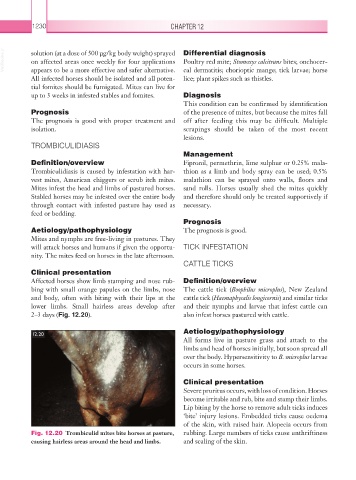Page 1255 - Equine Clinical Medicine, Surgery and Reproduction, 2nd Edition
P. 1255
1230 CHAPTER 12
VetBooks.ir solution (at a dose of 500 μg/kg body weight) sprayed Differential diagnosis
Poultry red mite; Stomoxys calcitrans bites; onchocer-
on affected areas once weekly for four applications
appears to be a more effective and safer alternative.
lice; plant spikes such as thistles.
All infected horses should be isolated and all poten- cal dermatitis; chorioptic mange; tick larvae; horse
tial fomites should be fumigated. Mites can live for
up to 3 weeks in infested stables and fomites. Diagnosis
This condition can be confirmed by identification
Prognosis of the presence of mites, but because the mites fall
The prognosis is good with proper treatment and off after feeding this may be difficult. Multiple
isolation. scrapings should be taken of the most recent
lesions.
TROMBICULIDIASIS
Management
Definition/overview Fipronil, permethrin, lime sulphur or 0.25% mala-
Trombiculidiasis is caused by infestation with har- thion as a limb and body spray can be used; 0.5%
vest mites, American chiggers or scrub itch mites. malathion can be sprayed onto walls, floors and
Mites infest the head and limbs of pastured horses. sand rolls. Horses usually shed the mites quickly
Stabled horses may be infested over the entire body and therefore should only be treated supportively if
through contact with infested pasture hay used as necessary.
feed or bedding.
Prognosis
Aetiology/pathophysiology The prognosis is good.
Mites and nymphs are free-living in pastures. They
will attack horses and humans if given the opportu- TICK INFESTATION
nity. The mites feed on horses in the late afternoon.
CATTLE TICKS
Clinical presentation
Affected horses show limb stamping and nose rub- Definition/overview
bing with small orange papules on the limbs, nose The cattle tick (Boophilus microplus), New Zealand
and body, often with biting with their lips at the cattle tick (Haemaphysalis longicornis) and similar ticks
lower limbs. Small hairless areas develop after and their nymphs and larvae that infest cattle can
2–3 days (Fig. 12.20). also infest horses pastured with cattle.
Aetiology/pathophysiology
12.20
All forms live in pasture grass and attach to the
limbs and head of horses initially, but soon spread all
over the body. Hypersensitivity to B. microplus larvae
occurs in some horses.
Clinical presentation
Severe pruritus occurs, with loss of condition. Horses
become irritable and rub, bite and stamp their limbs.
Lip biting by the horse to remove adult ticks induces
‘bite’ injury lesions. Embedded ticks cause oedema
of the skin, with raised hair. Alopecia occurs from
Fig. 12.20 Trombiculid mites bite horses at pasture, rubbing. Large numbers of ticks cause unthriftiness
causing hairless areas around the head and limbs. and scaling of the skin.

